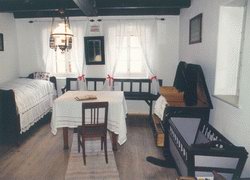About 10km in the northwestern direction of Nové Mesto nad Váhom, in the centre of the Bošácka valley is situated village Bošáca. The first written mention of village is a
pergamen from 1380 with the former name Bosach. (1398 possessi Bosach, 1479 Besach villa Bsacz, 1506 possessio Bosacz, 1773 Bosacza). The Hungarian name of
village was Bosác.
Coat-of-arms was taken from the former seal of village and is formed by St Nicolaus dressed in silver in a blue field. Village is situated on the border of
the White Carpathians, absolute altitude 228m, 1350 inhabitants.
Access: by train from Trenčín or Nové Mesto nad Váhom to Trenčianske Bohuslavice, by bus from Trenčín and Nové Mesto nad Váhom to Bošáca.
Points of interest, remarkables and rarities

At the entry to village your attention will be drawn by the Baroque Church from 1733 with the classicistic adaptation from 1789. On the ceiling is a wall painting of J.Hanula
(1906). There is an open-air museum – the former rustic house with the former tools, furniture and other equipment. In the centre of village there is a famous Bošácka
distillery. Nice costumes of Bošáca are preserved in the Museum.

|
|
Farme salle in open-air museum Bosacka vale
|
Over Bošáca to the left there is Lysica hill (545m) suitable for hang-glidding. Near Rolincová settlement
is a ski-lift (400m). Access from a road to the left of post office. From the square in Bošáca we go to the right and come to Zabudišová settlement (2,5km) and if we go on,
we can come to hamlets of Haluzice and to mineral spring – the acidulous water of Haluzice.
From Bošáca came:
Eduard Šandorfi-Škrabánek, the Roman-Catholic priest, nationalist, herbalist and editor of magazines Kresťan, Posol sv. Antona, Listy sv. Antona. A memorial tablet is on a building of the former school of arts.
Ján Kusenda, organiser and participant of the meeting on May 1, in Liptovský sv. Mikuláš because of law acceptance for the Slovak nation.
Ľudovít Bránsky – academic painter.
Adam Adamovic – the Slovak nationalist who died on April 11, 1945 during liberation of France near Dunkerque.
General Štefan Jurech, commander of air weapons of the Slovak army, later put to death for its anti-fascist activity in 1945 in Berlin. Their names are written on the Cenotaph of the Slovak national uprising (SNP) in front of elementary school and on memorial tablets on facade of the municipality.
Translation: Bendíková